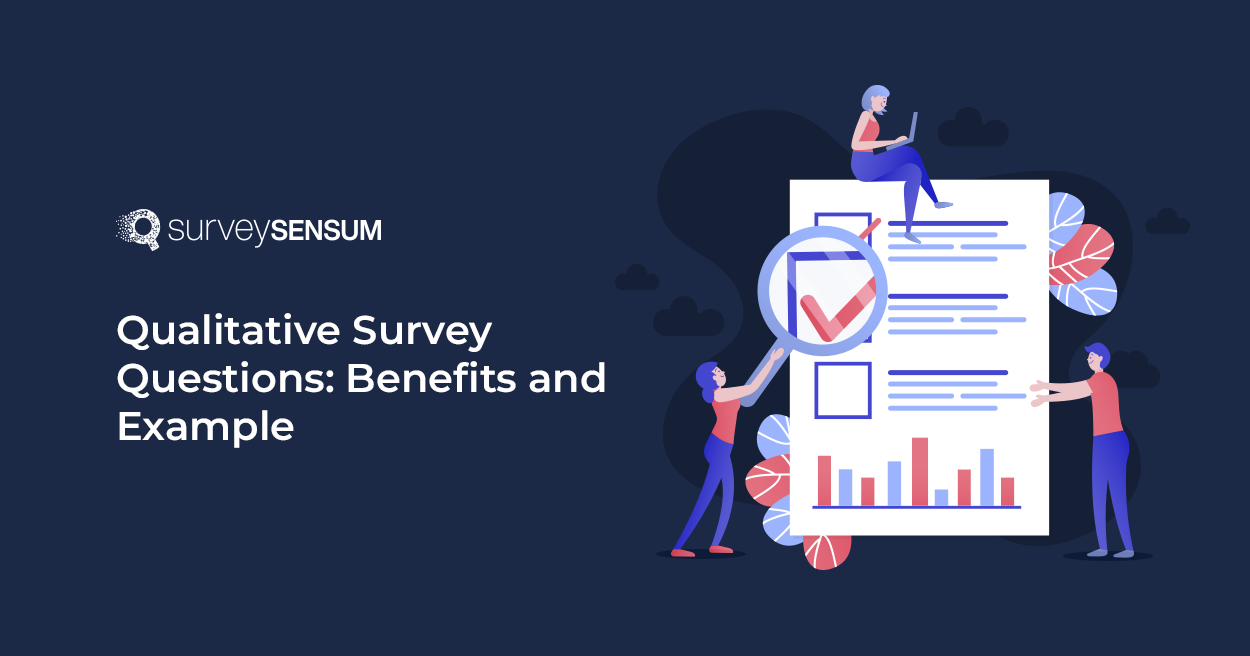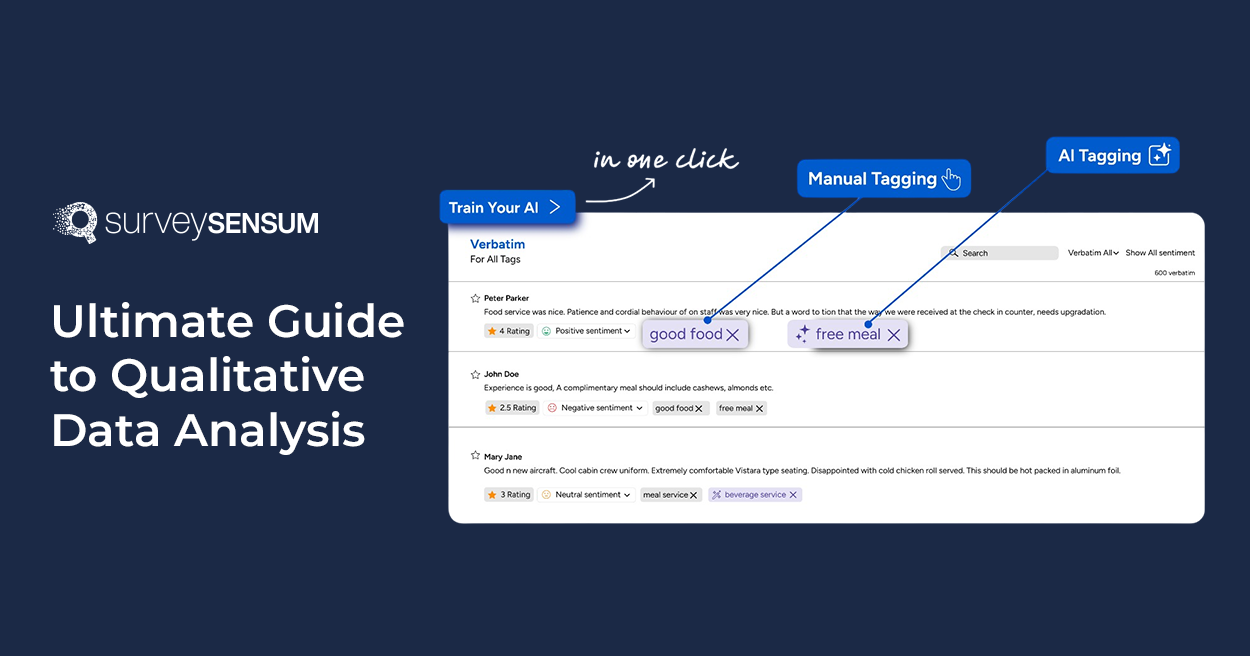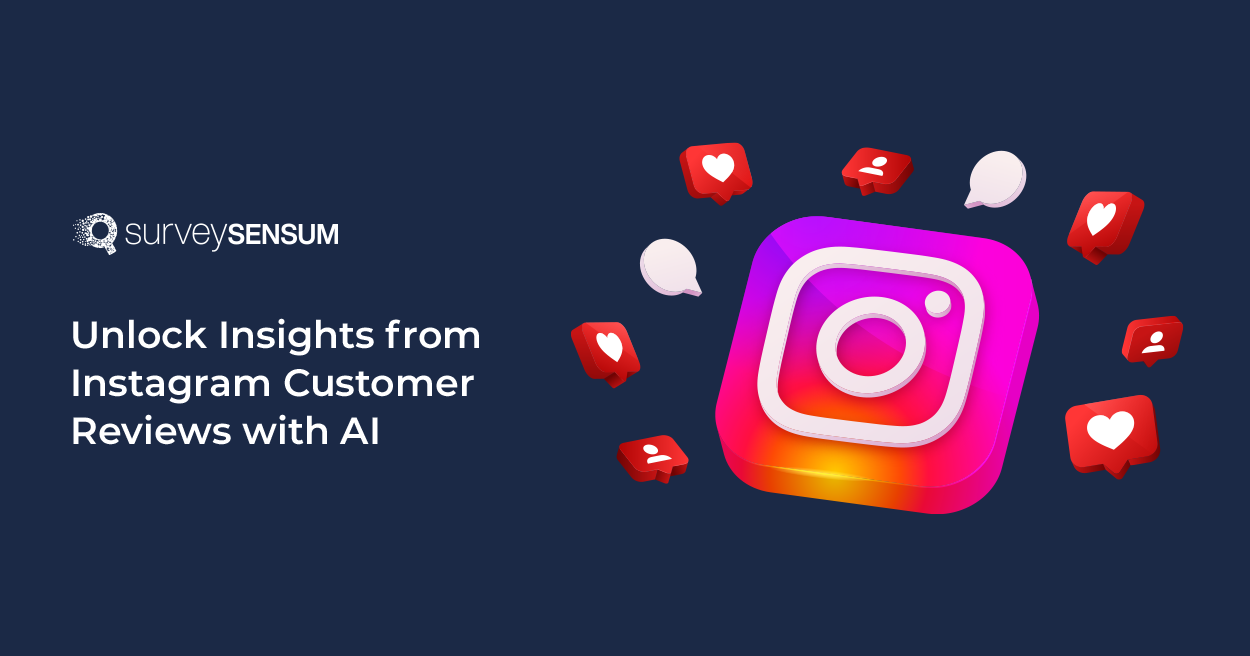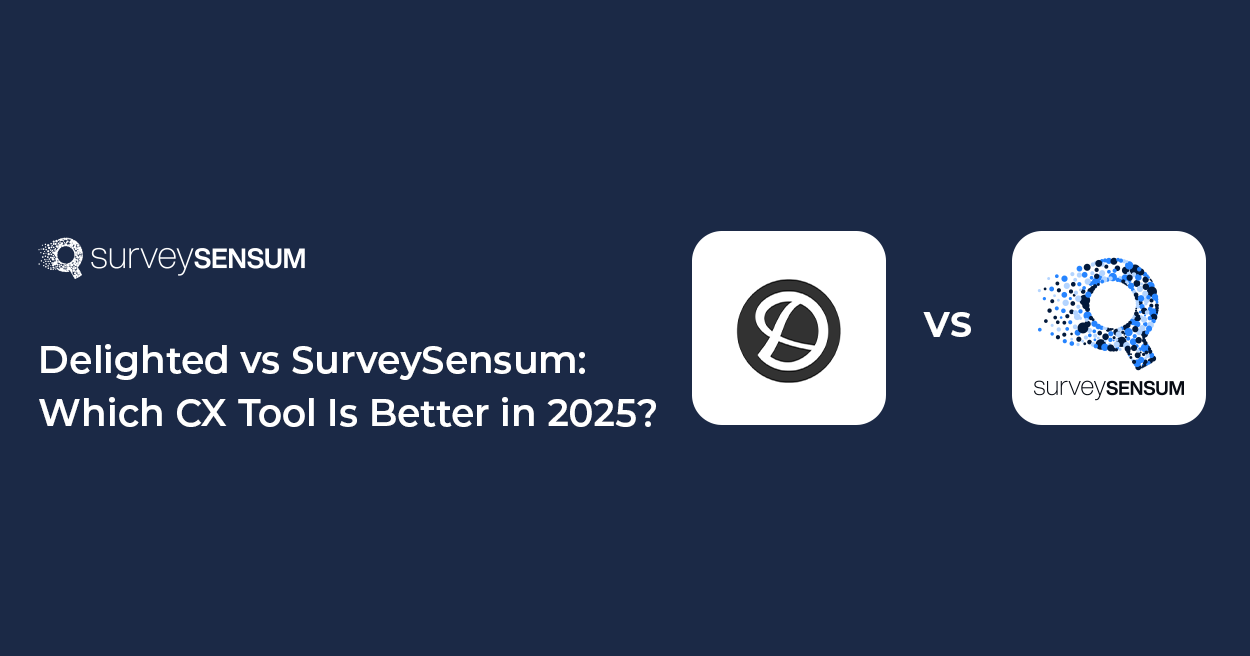

Want to uncover deeper insights, understand customer emotions, or explore complex issues?
Qualitative survey questions are the way to do it!
This blog explores everything you need to know about crafting effective qualitative survey questions to gather rich, descriptive data. We’ll talk about why qualitative questions are necessary for data collection, the various types you can use, and share practical examples to get you started. Plus, we’ll compare qualitative and quantitative questions to show how using both can provide a comprehensive understanding of your audience.
So, whether you’re new to surveys or looking to enhance your approach, stay tuned. We’re here to help you create surveys that capture the full story behind the data.
Ready to unlock deeper insights? Let’s dive in!
What are Qualitative Questions?
Qualitative survey questions are open-ended questions designed to gather in-depth insights and detailed feedback from respondents. Unlike quantitative questions that seek numerical data, qualitative questions explore the underlying reasons, motivations, and opinions behind respondents’ answers. These questions typically require more detailed and elaborated responses, allowing for richer and more nuanced data collection.
→ Basically if you want to understand the ‘Why’ behind the feedback then Qualitative survey questions are for you.
For instance, why did Rachel give the score of 5 or what kind of support issue did Max face – qualitative question answers these questions!

Key Characteristics of Qualitative Survey Questions:
- Open-ended: They do not have predefined response options and encourage respondents to answer more freely, in their own words.
- Exploratory: They aim to uncover underlying thoughts, feelings, and behaviors.
- Detailed: They allow for comprehensive and elaborate responses, providing deeper insights into the topic.
But why make such a fuss about using them in surveys?
Why Use Qualitative Survey Questions?
Using qualitative survey questions offers several advantages, particularly when the goal is to gain a deeper understanding of respondents’ thoughts, feelings, and behaviors. Here are some key reasons to use qualitative questions:
1. Depth of Insight
Qualitative questions allow respondents to provide detailed and nuanced answers. This depth of insight can uncover underlying motivations, emotions, and reasons behind their behaviors and attitudes, which quantitative data may not reveal.
2. Exploratory Research
When entering a new market, developing a new product, or exploring new concepts, qualitative questions help gather exploratory data. They enable businesses to understand the complexities of a topic and identify patterns, themes, and areas for further investigation.
3. Richness of Data
Qualitative responses provide rich, descriptive data that can be used to create detailed narratives, case studies, and personas. This richness helps in understanding the context and background of respondents’ experiences.
4. Flexibility
Respondents can answer in their own words, providing information that might not fit into predefined categories. This flexibility can reveal unexpected insights and highlight issues that were not initially considered.
5. Identifying Key Issues
By asking open-ended questions, researchers can identify key issues, pain points, and areas for improvement that are most important to respondents. This helps in prioritizing actions and making informed decisions.
6. Enhancing Quantitative Data
Qualitative questions can complement quantitative data by providing explanations and context for the numbers. For example, if a survey shows a low satisfaction score, qualitative questions can help understand the reasons behind this dissatisfaction.
7. Capturing Emotional and Subjective Experiences
Quantitative data often fails to capture the emotional and subjective aspects of respondents’ experiences. Qualitative questions allow for the expression of feelings, opinions, and personal stories, providing a more holistic view of the customer experience.
8. Generating Hypotheses
Qualitative data can help generate hypotheses for further testing and exploration. The insights gained from qualitative responses can guide the development of future quantitative surveys or experiments.
9. Tailored Responses
Respondents can provide answers tailored to their specific experiences and perspectives, leading to a more personalized understanding of their needs and preferences.
Examples of When to Use Qualitative Questions
- Customer Feedback: To understand the reasons behind customer satisfaction or dissatisfaction.
- Product Development: To gather ideas and suggestions for new features improvements or product adoption.
- Market Research: To explore consumer attitudes and behaviors in a new market.
- User Experience: To capture detailed user experiences and identify usability issues.
- Employee Feedback: To understand employee morale, job satisfaction, and workplace culture.
In summary, qualitative questions are invaluable for gaining a deeper, more comprehensive understanding of complex issues, providing rich, contextual data that can inform decision-making and drive improvements.
Ready to take your data collection to the next level? Start crafting your surveys with SurveySensum ‘s different question types and gather the rich, qualitative insights you need to make informed decisions. Try it now! S
Types Of Qualitative Survey Questions
Qualitative survey questions are open-ended and designed to elicit detailed, narrative responses that provide deeper insights into respondents’ thoughts, feelings, and experiences. Here are some common types and examples of qualitative survey questions:
1. Open-ended Questions
These questions allow respondents to express their thoughts freely without being restricted to predefined options.
- Example: “What do you think about our new product design?”
2. Experience-Based Questions
These questions ask respondents to describe specific experiences related to the topic of interest.
- Example: “Can you describe a time when you had an exceptional customer service experience with us?”
3. Opinion-Based Questions
Opinion-based questions seek to understand respondents’ viewpoints or beliefs about a subject.
- Example: “What is your opinion on the recent changes to our website?”
4. Follow-Up Questions
Follow-up questions are used to delve deeper into initial responses and can help uncover underlying reasons or motivations.
- Example: “You mentioned that you found the product useful. What specific features did you find most beneficial?”
5. Hypothetical Questions
These questions present a hypothetical scenario to understand respondents’ potential reactions or decisions.
- Example: “If we were to introduce a new feature, what would you like it to be and why?”
6. Clarification Questions
Clarification questions ensure that the respondent’s answer is fully understood by asking for more details or examples.
- Example: “Can you clarify what you mean by ‘difficult to use’?”
7. Reflective Questions
Reflective questions ask respondents to think back on their experiences and reflect on changes or impacts.
- Example: “How has your perception of our brand changed over the past year?”
8. Comparative Questions
Comparative questions ask respondents to compare two or more items, experiences, or periods.
- Example: “How does our current customer service compare to your experiences with other companies?”
9. Narrative Questions
These questions invite respondents to tell a story or describe a sequence of events.
- Example: “Can you walk me through your experience from the moment you decided to purchase our product to the point of making the purchase?”
20 Examples Of Qualitative Questions
Here are 20 examples of qualitative questions that can be used in various research contexts to gather detailed, narrative responses:
Customer Experience and Satisfaction
- Can you describe a recent experience you had with our customer service?
- What do you like most about our product/service?
- What aspects of our product/service do you find most challenging or frustrating?
- Can you tell us about a time when our product/service exceeded your expectations?
- What improvements would you suggest for our product/service?
Product Feedback and Development
- What features do you find most useful in our product?
- Can you describe a feature you think is missing from our product?
- How does our product compare to others you have used in the past?
- Can you tell us about a situation where our product helped you solve a problem?
- What changes would make our product better meet your needs?
Marketing and Branding
- What first comes to mind when you think of our brand?
- Can you describe your feelings towards our recent advertising campaign?
- What factors influenced your decision to choose our product over competitors’?
- How do you perceive our brand compared to others in the market?
- What would you tell a friend about our brand?
Employee Experience and Engagement
- What do you enjoy most about working here?
- Can you describe a time when you felt particularly motivated at work?
- What challenges do you face in your current role?
- What changes would improve your work environment?
- How do you feel about the communication and support from management?
These questions are open-ended, encouraging respondents to share their thoughts and experiences in detail, and providing rich qualitative data that can be used to gain deeper insights into their perspectives.
Transform your survey data into rich, descriptive insights by leveraging qualitative questions. SurveySensum provides the tools you need to create impactful surveys. Sign up and start exploring today!
Qualitative Vs Quantitative Questions
Here’s a table comparing qualitative and quantitative questions:
| Aspect | Qualitative Questions | Quantitative Questions |
| Nature | Exploratory, open-ended | Numerical, closed-ended |
| Objective | Understand underlying reasons, motivations, and meanings | Measure and quantify data, identify patterns |
| Data Type | Non-numerical, descriptive | Numerical, measurable |
| Example Questions | “Why do you prefer this product?” | “How many times do you use this product per week?” |
| Data Collection Methods | Interviews, focus groups, open-ended surveys | Surveys with structured questions, experiments |
| Outcome | In-depth insights, detailed understanding | Generalizable results, trends, and correlations |
| Use Cases | Exploring new phenomena, generating hypotheses | Testing hypotheses, measuring the extent of phenomena |
| Response Format | Narrative, text-based responses | Fixed-response, scale-based responses |
Qualitative questions gather detailed responses, offering in-depth insights into thoughts and experiences through open-ended formats. They explore complex issues and uncover new ideas. Quantitative questions collect data that can be analyzed statistically, using closed-ended formats for easy aggregation.
By using both types of questions in your surveys, you can create a more comprehensive feedback process, capturing both the stories behind the numbers and the trends that drive them.
Conclusion
In conclusion, qualitative survey questions are essential tools for gathering comprehensive insights. They allow you to delve deep into the emotions, motivations, and experiences of your respondents, providing rich, descriptive data that adds context and depth to your research.
By integrating both qualitative and quantitative questions in your surveys, you can capture a holistic view of your audience, balancing detailed narratives with concrete data. This dual approach ensures that you not only understand the “what” and “how many” but also the “why” and “how.”
So, streamline your survey creation process and ensure you gather the most actionable insights using SurveySensum. SurveySensum’s intuitive platform helps you design, distribute, and analyze surveys efficiently, making it easier to combine qualitative and quantitative questions for a well-rounded research strategy.
FAQs
A qualitative survey questionnaire consists of open-ended questions designed to gather detailed and descriptive responses. For example, qualitative questions examples in a survey for a restaurant might include questions like:
- “Can you describe your overall experience at our restaurant?”
- “What dishes did you enjoy the most and why?”
- “How did you feel about the ambiance and service?”
This type of questionnaire aims to uncover in-depth insights about customers’ experiences, preferences, and perceptions.
Here are five qualitative survey questions examples that can be used in a variety of contexts to gather detailed responses:
- “Can you describe a recent experience you had with our customer service?”
- “What do you find most valuable about our product/service?”
- “How has using our product/service impacted your daily life?”
- “What challenges have you encountered while using our product/service?”
- “What changes or improvements would you like to see in our product/service?”
Good qualitative research questions are open-ended, clear, and designed to elicit detailed responses that provide deep insights. They should encourage participants to share their thoughts, experiences, and feelings. Qualitative survey questions examples include:
- “How do you perceive the impact of remote work on your productivity and work-life balance?”
- “What motivates you to choose one brand over another in the marketplace?”
- “Can you describe your experience transitioning from traditional to online education?”
The qualitative survey method involves collecting detailed, narrative data through open-ended questions in surveys or interviews. This method aims to understand the underlying reasons, opinions, and motivations of respondents. It often involves smaller sample sizes compared to quantitative surveys but provides richer, more in-depth data.
Design, distribute, and analyze surveys efficiently with qualitative and quantitative questions for a well-rounded research strategy. Begin your journey to deeper insights now! Try SurveySensum for free!

















